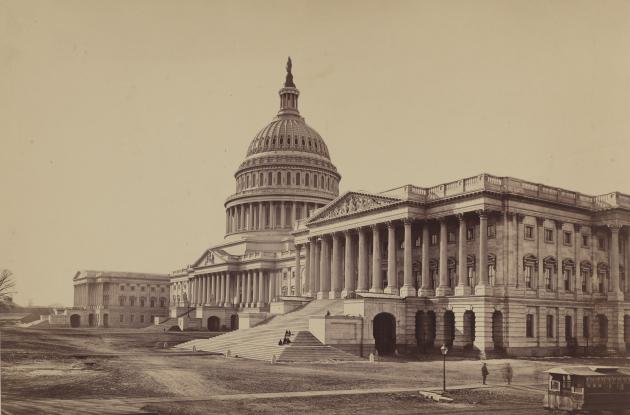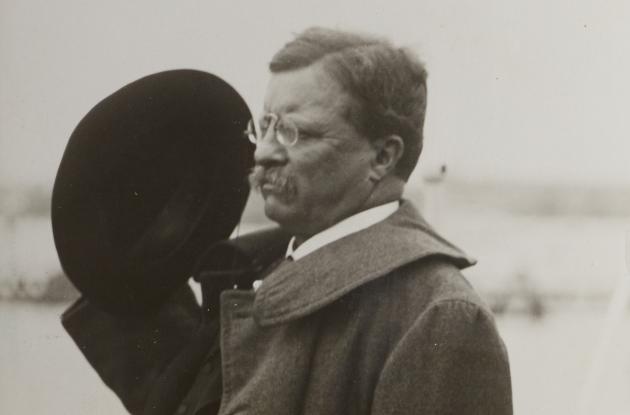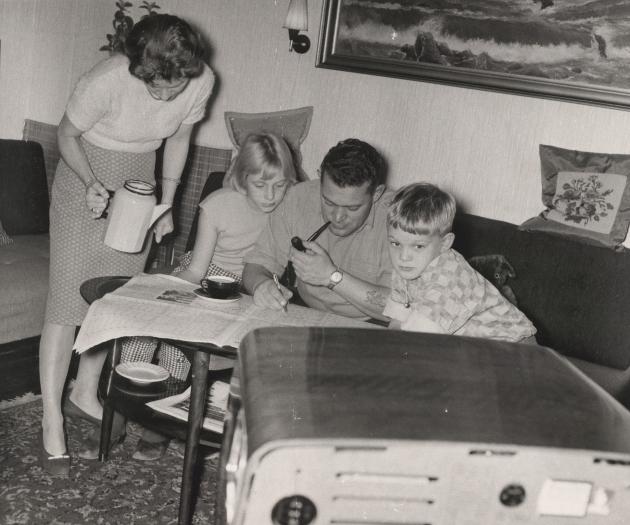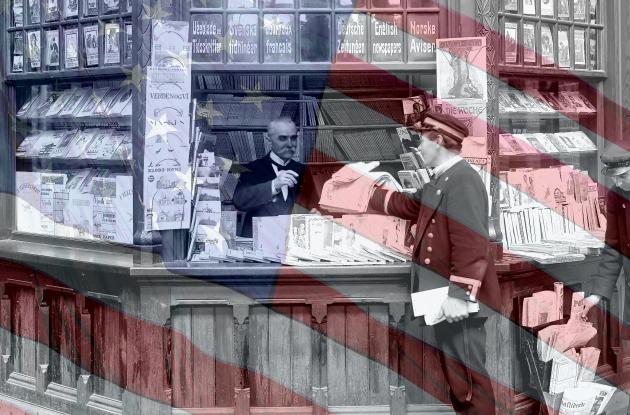American presidential election
On 5 November 2024, Americans will go to the polls for the 60th time. We have taken a dive into the collections and looked at how the election has been covered in Denmark over time.
Since 1788, with few exceptions, there have been presidential elections in the United States every four years, and on 5 November 2024, the President of the United States will be elected for the 60th time. For the Americans, the choice is between Democrat Kamala Harris and Republican Donald Trump.
In Denmark, you can follow the election through television, radio, newspapers and social media - you can get information every day, around the clock. But how have the elections been covered in Denmark, both when the only news media was the newspaper and before the Internet really took off?

Photo: Ubekendt fotograf
The first female presidential candidate
If Kamala Harris wins the presidential election, she will become the country's first female president, but she is far from the first woman to seek the presidency.
As early as 1872, the first woman ran for president of the United States, her name was Victoria Woodhull. She got a very small share of the votes, and information about her in the Danish newspapers is sparse. In an article about women's activists, the newspaper "Fædrelandet" 22 May 1872 writes as follows:
One should therefore by no means see all such efforts for freedom in a ridiculous light; but beside these examples many can be mentioned where folly and foolishness are so predominant that female emancipation becomes nothing more than vanity and humbug. And among them, the most prominent is Victoria Woodhull, who is running as a candidate for the Presidency of the United States (...)
The debate today is somewhat more nuanced, but in 1872, when Woodhull ran, women did not yet have the right to vote in the United States. Furthermore, Victoria Woodhull would not be able to take office if she had won because she was only 33 and thus too young to be president, where the age limit is 35.
Live blog or morning paper
It was hard to avoid the news that Donald Trump had been shot at during a rally in Pennsylvania. News sites were flooded with live blogs and photos documenting the seconds before and after the shots. If you were awake at night when the assassination attempt took place Danish time, you could have followed the events in real time.
But Trump is not the first presidential candidate to be shot. Before him, a long line of US presidents and presidential candidates have been victims of assassination attempts.

Photo: Holger Damgaard
On 14 October 1912, a voter meeting also developed into a very dramatic event. Republican President Theodore Roosevelt had gone to Milwaukee to campaign for the presidency and took a tour of the city before giving a speech.
Standing in an open car to greet the audience, the good atmosphere was interrupted. Suddenly, a bullet flew through the air and hit Roosevelt in the chest, panic spread in the crowd, but the assassination attempt did not stop the presidential candidate.
The bullet had drilled through Roosevelt's steel eyeglass case and the 50-page speech he was to deliver later, slowing it somewhat. Still, the projectile had lodged in Roosevelt's chest. Instead of calling off the campaign, Roosevelt took to the podium and delivered his prepared speech, which lasted nearly an hour.
Roosevelt was a bit of a macho man who had both owned a cattle ranch in the Wild West and led the volunteer cavalry regiment Rough Riders in the Spanish-American War. He judged that since he was not coughing up blood, the bullet must have passed through the lungs.
Two days later, 16 October, the news had hit the Danish newspapers. The newspaper "Riget" reported that the bullet lodged in one side of the chest, but had avoided the lung, and that Roosevelt had later been taken to hospital. About the perpetrator they wrote: He is, by all accounts, insane
. In addition, the newspaper wrote that the perpetrator possessed notes in which he protested against Roosevelt's candidacy.
According to Holbæk Amts Venstreblad, Theodore Roosevelt's opponent, Woodrow Wilson, had been the favourite for a long time, but the assassination attempt against Roosevelt had reportedly improved Roosevelt's chances of winning. In the end, however, it was the Democrat Woodrow Wilson who ran away with the victory.
Close race and unclear election results
In 2024, the internet is full of photo reports from voter meetings, insights into the lives of the presidential candidates and daily analyses of the possible outcome of the election. Regardless of the amount of analysis, it is impossible to predict the outcome of the election with 100% certainty, it has always been that way, but even after the election is over, it can be difficult to fully decipher the result.
24 years ago, the election was also covered online, and the event even had its own section on DR's website and is preserved in Royal Danish Library's online archive. Online you could read about the dramatic development of the election, watch the speeches of the presidential candidates after the election or take a quiz about whether you were a Democrat or a Republican.
In 2000, when the election was between Republican George W. Bush and Democrat Al Gore, even after the election it was unclear who would take over the chair in the White House. The election was decided after a recount in the state of Florida, where Bush got 537 more personal votes than Gore and thus won the state and the title of President of the United States. Bush even won with only five electoral votes, while Al Gore got the most personal votes.

Photo: Asger Sessingsø
In the US, it is not about getting the most personal votes, as it is in Denmark. In the American electoral system, the candidate with the most electoral votes wins the election. Each of the 50 states of the United States has been assigned a certain number of electors depending on the size of the state. So if a candidate gets the most personal votes in California, for example, the candidate gets all the electoral votes in that state.
In order to be able to take the place of President of the United States, it is therefore required that you have the majority of the electoral votes. The presidential candidates are fighting for 538 electoral votes, and 270 are therefore required to win the election.
There is no doubt that the Danish coverage of American elections has changed a lot since the country elected its first leader. From newspaper articles and short analyses to comprehensive reports with colourful images. We don't know who will win the election, but we do know that it will probably not be difficult to stay updated.
